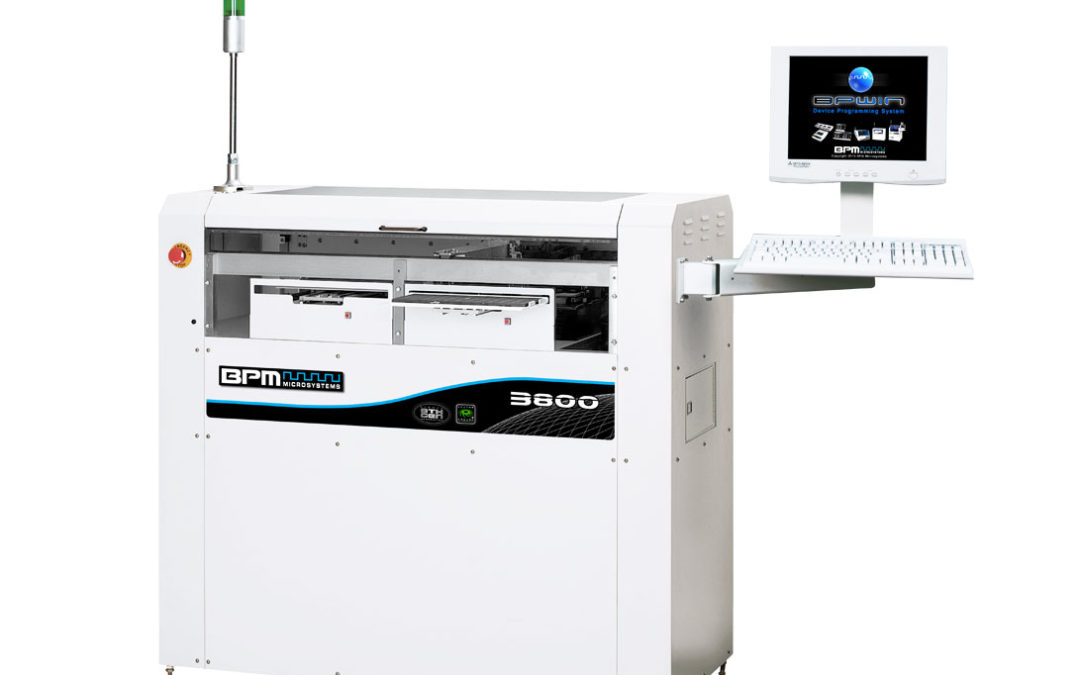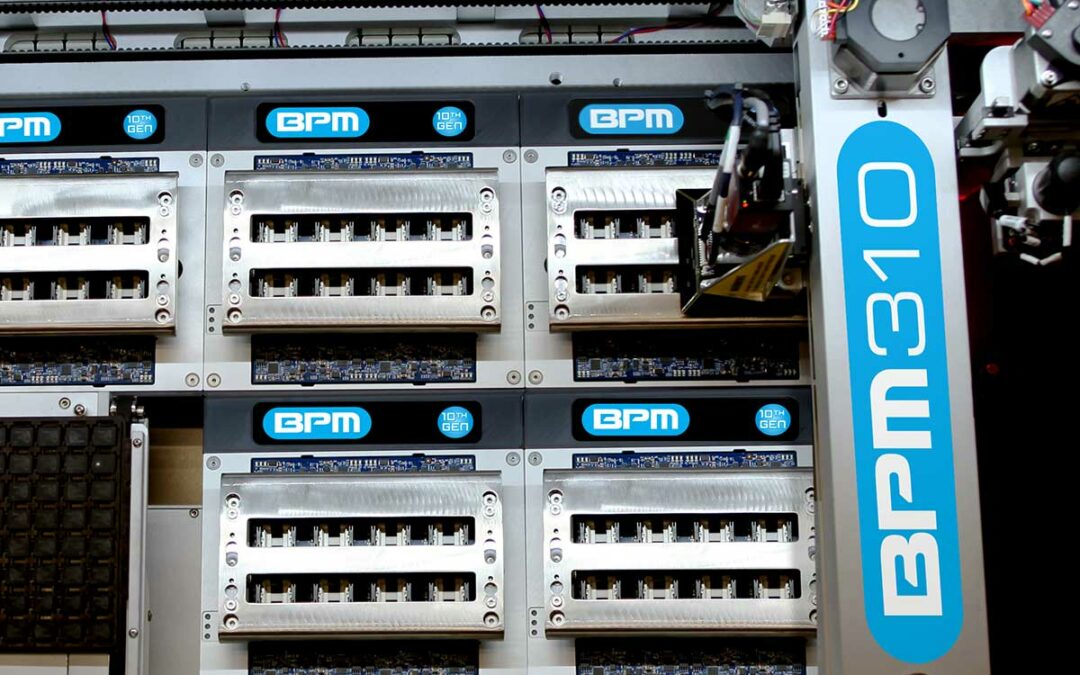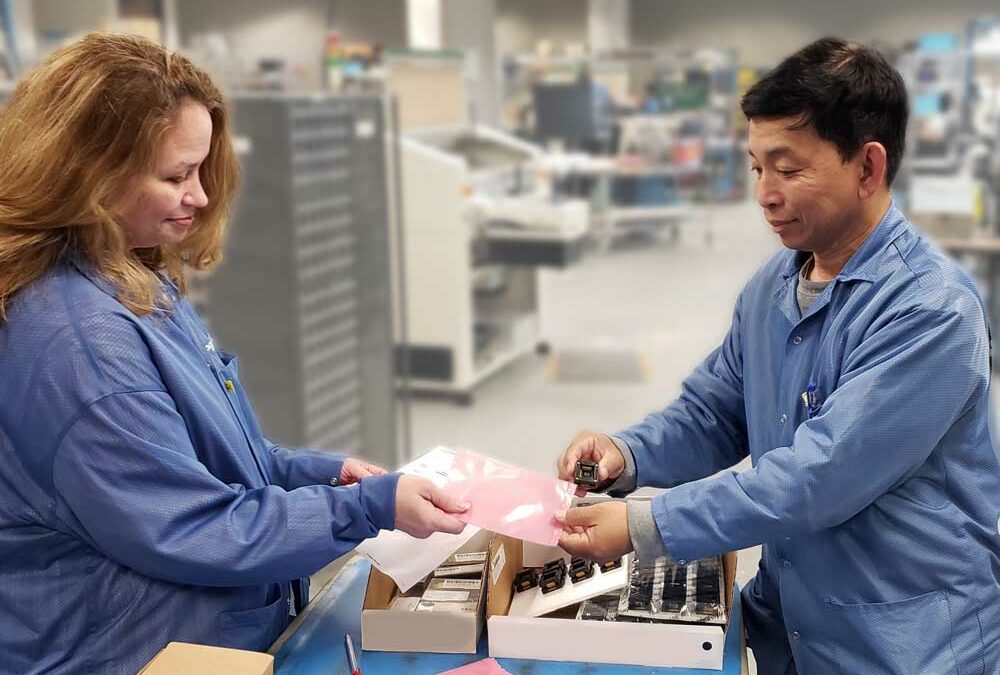
by Scott Bronstad | Feb 21, 2022 | Announcements, End Of Life
BPM Microsystems announces the end of life for legacy 3000 series Automated Programming Systems including the following models: 3610, 3710MK2, 3000FS, and 3800
Details
Effective February 21, 2022, BPM Microsystems announces the following end-of-life plan for legacy 3000 series Automated Programming Systems.
- CyberOptics Sensor – Replacement CyberOptics sensors are no longer available for purchase.
- As of March 14, 2022, BPM can no longer repair damaged legacy CyberOptics cameras.
- Modern 9th and 10th Generation CyberOptics cameras are available for purchase and repair.
- Pick/Place Handler – Repair and replacement parts will be sold on a best effort basis.
- Peripheral Options – Repair and replacement parts will be provided on a best effort basis.
- Programming Site Technology – Non-warranty repairs for 6th, 7th, Flashstream, and 8th Generation programming site technology will be repaired on a best effort basis only.
- Algorithms and Software Updates – Customers with valid support contracts can continue to request algorithms and access BPWin software updates.
- Software Support Contracts – Customers can continue to purchase BPWin software support contracts.
- Hardware Support Contracts – Effective immediately extended warranty renewals will be offered on a case by case basis. BPM will continue to honor those existing hardware support contracts in place at that time of this notice.
- Socket Modules, Daughter Cards, Socket Cards, and Replacement Sockets – Customers can continue to purchase “adapter” products with the exception of those obsolete or discontinued items.
Introduced by BPM Microsystems in 1999, the 3000 series handler has offered exceptional return on investment and productivity for over 22 years. We recognize that many customers continue to use these platforms, programming millions of devices per year. Supply chain constraints, key component availability and increasing cost of support are driving this decision. We encourage customers to contact Customer Service and Sales to discuss upgrade and trade-in options.

by Scott Bronstad | Feb 17, 2022 | Case Study, How To, News
Sweat the Details
Two metrics in device programming are super-important (but the third might be even more important). Here are several questions to ask:
- What can I expect for up-time and utilization for my Device Programmer?
- How does BPM ensure the highest quality and accuracy of finished programmed devices?
- How does BPM deliver the cleanest waveforms? Why are clean waveforms important?
Up-Time/Utilization Rates
With routine maintenance and yearly calibration, BPM systems are designed for maximum uptime. Many factories worldwide run their Automated Programming Systems 6 days a week/3 shifts a day. For purposes of allocation, BPM recommends using an 85% utilization rate (but you may find it above 90% in actual use). BPM’s systems are easy to set up, especially compared to other comparable systems, making their utilization rate the best in class.
Accuracy
BPM ensures accuracy and repeatability for device programming In three main ways: Auto-teach, Vision Alignment, and Job Automation. All programming systems are highly repeatable– once they are set up, they will reliably repeat their program (even if it isn’t perfect). The trick is to start with a perfect setup, resulting in repeatable, reliable, and accurate yield.

A: Teach too high may cause misalignment. B: Teach too low may cause micro-fractures that oxidize over time. The device may pass the initial test only to fail in the field
WhisperTeach™ is BPM’s patented process to “auto-teach” the critical Z-height of input-output locations and sockets. You see, it’s easy, with a downward camera, to center the X/Y coordinates in the input/output and socket locations (and if you are off slightly, BPM’s on-the-fly vision centering auto corrects and auto centers). But there is no camera to precisely place and pick up the Z (up and down). Some locations are more difficult than others because of where in the machine they are. But even in the “easy” locations, a human operator can only see to about 45 microns (slightly smaller than the width of a human hair). WhisperTeach is a major factor in BPM’s systems ease and speeds up set-up without sacrificing quality– it’s more accurate (within 15 microns) than a human operator, even a highly trained technician.
For on-the-fly vision alignment, BPM systems utilize a CyberOptics LNC-120 camera which precisely spins the device between the input/output location and the socket without requiring the system to slow down. This boosts DPH (Devices per Hour) without sacrificing quality. BPM’s systems can handle the smallest chip-scale packages in the industry (as small as 1mm x 0.5mm).
Finally, Job Automation allows multiple workflows to be stored and retrieved quickly. BPWin, BPM’s Process Software, calls this application JobMaster. It allows you to prepare programming jobs to meet precise specifications, and then save the jobs for future use for repeatable quality.
BPM’s programming site technology has its origins in test equipment. Everything, from the pin drivers to the gold-plated contacts on sites and sockets, is designed to deliver the cleanest waveforms. If you want to know more, read the Signal Integrity article here. For the short version, signal integrity delivers maximum quality and device life expectancy (you don’t want “device amnesia“).
Clean waveforms give you programming results that you can count on and the highest first-pass yields.

by Scott Bronstad | Feb 15, 2022 | How To
Largest Non-Machine Cost
A huge roadblock in bringing your device programming in-house might be the prospect of staffing. Here are several questions to ask your Programming Equipment Supplier:
- Does your system require an experienced technician?
- How long does it take for someone to be trained to operate the system?
- What happens if we need to operate a second or third shift to keep up with demand?
- Does the machine have any special requirements, such as filtration or ESD mitigation?
- What about maintenance and up-time?
 Experienced Technician Not Required
Experienced Technician Not Required
The automated systems from BPM are designed and built in the USA to make device programming fast and easy while providing the best quality and highest throughput in the world.
Anyone Can Be Trained
Just about anyone with a couple of hours of training can operate any of BPM’s programmers. That also means no quality drop-off on your second or third shift crews.
No Special Requirements
BPM’s programmers have a small footprint, with no special room requirements other than power (20A 240VAC (+/- 10%)), compressed air, and HVAC to control humidity and temperature. While not a requirement for operation, BPM recommends an APS ionization kit (F3XIONIZER) for maximum throughput and highest quality output.
90% Plus Uptime/Utilization Rate
BPM systems are built to last with routine maintenance and tune-ups. There are hundreds of BPM automated programming systems still in use after more than 10 years (some after nearly 20 years of use).

by Scott Bronstad | Feb 3, 2022 | Announcements, News
One Year Later, Supply Chain Shortages Continue
Last year, BPM did a three-part series on the supply chain crisis (see links at the end of this article). Originally affecting automotive manufacturers, it soon spread like wildfire to other industries as manufacturers vied for the diminishing inventories of critical parts and components. Nowadays, everyone is aware of higher prices, longer turn-around times, and empty store shelves. The situation is a mess, and we may be dealing with this “new normal” for the foreseeable future.
BPM Supply Chain Update
BPM Microsystems is in the same boat, so to speak, as the rest of the world. They are dealing with some critical shortages that are affecting future delivery (more on that below); fortunately, BPM took the supply chain crisis seriously, and early. In addition, there are some built-in factors that have helped weather this storm. Here’s a list of the main ways BPM has gotten ahead of supply chain shortages:
- Builds/maintains inventory for critical components and spares
- Develops multiple suppliers rather than a single source
- Sources parts/materials from a variety of geographic regions, both domestic & international
- Has vertical manufacturing capability
- Controls design from top to bottom
- Utilizes common design architecture/software across multiple products
Here are some specifics.
Builds inventory
Automotive shortages started in the middle of 2020 as Covid-19 lockdowns were at their worst. BPM began to identify critical supplies and parts in the third quarter of 2020, updated inventory levels, and updated reorder thresholds. So far, only one programmer supply has been affected: the 1710 Manual Programmer. You can see updates on 1710 here. We currently have a small inventory available; to help in the short term, BPM has developed the 1710M (Military-spec version of 1710) that is available for delivery in the US only.
Multiple Suppliers, Multiple Geographical Sources
Identifying additional sources for critical inventory isn’t always easy, but it’s very important. Costs, minimum orders, and turn-around times vary, so it’s vital (when possible) to have options when it comes to parts. In the case of the 1710 programmer, it was a Microsemi FPGA that is only manufactured and distributed with a 52+ week lead-time. With all their other critical components, BPM was able to find suppliers.
BPM Distinctives
BPM has some “baked-in” manufacturing advantages, especially in light of the supply chain crisis. Vertical manufacturing: BPM’s manufacturing facility is located in their home office in Houston, Texas. They typically use generally available sourced components in their manufacturing process. Control design from top to bottom: All of BPM’s programmers and site technology is designed and manufactured on-site with globally-sourced parts. All of their designs and software are “locked-down” to ensure they cannot be reverse-engineered. This protects their intellectual properties. They also use common design architecture across multiple products, such as sites, sockets, and software. For instance, the 2900 Manual Programmer utilizes almost the same site technology as the 3901 and 3928 Automated Programmers (the only difference is the chassis and the stepper motors on the automated systems).
BPM Delivers
BPM continues to ship products in the face of the supply chain shortage. They utilize a first-in, first-out ordering process for back-ordered items; it is recommended to contact BPM in advance of your needed replacement or new product to ensure its timely delivery. In short, BPM is doing everything it can to deliver device programming solutions to you.
To find out more, please contact BPM email or by phone: +1 (713) 688-4600 | Sales Toll-Free: (855) SELL BPM | 24/7 Service: +1 (832) 617-5702.
See more supply chain articles:

by Scott Bronstad | Jan 26, 2022 | News, Trade Shows, Video
APEX 22 Live with Mike Konrad and Colin Harper
Mike Konrad is the founder of Aqueous Technologies, a manufacturer of automated cleaning and cleanliness testing systems designed for the electronic assembly industry, and has served as its CEO/CTO since 1992. Mike is the host of the Reliability Matters podcast, available on iTunes, Spotify, and spreaker.com.
Colin Harper is the Director of Sales and Product Marketing at BPM Microsystems.
This interview was originally live-streamed on January 26, 2022. The 3+ hour live stream is queued up to when Colin is interviewed.




 Experienced Technician Not Required
Experienced Technician Not Required
